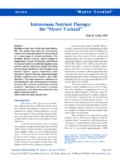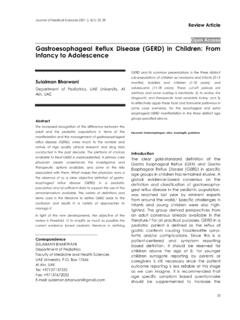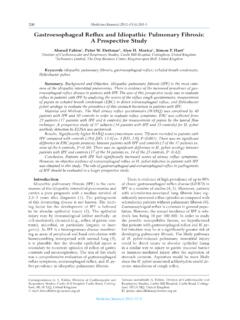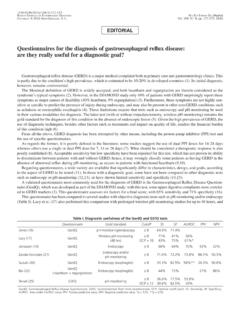Transcription of Gastroesophageal Reflux Disease (GERD): A Review …
1 AmrVolume 16, Number 2 Alternative Medicine Review 116 Copyright 2011 Alternative Medicine Review , LLC. All Rights Reserved. No Reprint Without Written Permission. Review ArticleAbstractGastroesophageal Reflux disorder (GERD), a common disorder in the Western world, can lead to complications that include esophageal stricture and esophageal adenocarcinoma. Multiple challenges are associated with GERD treatment. First, lack of symptoms does not correlate with the absence of or the healing of esophageal lesions. Second, proton pump inhibitors, the current standard of care for GERD, are ineffective for the majority of GERD patients who have non-erosive Disease . This article discusses these challenges, investigates the mechanisms of damage in GERD, and explores the existing data on unconventional forms of treatment, including melatonin, acupuncture, botanicals, and dietary interventions.
2 (Altern Med Rev 2011;16(2):116-133)IntroductionGERD is defined as a condition that develops when the Reflux of stomach contents causes troublesome symptoms and/or complications. 1 Heartburn, estimated to occur daily in seven percent of the population, is the most common symptom of Between 20 and 40 percent of those experiencing common heartburn are predicted to actually have a diagnosis of GERD. In addition to heartburn, regurgitation and difficulty swallowing are common GERD symptoms. GERD also includes subcategories of diagnosis: non-erosive esophageal Reflux Disease (NERD) and the additional pathologies that result as GERD progresses, including esophageal ulcer, esophageal stricture, Barrett s esophagus, and Barrett s carcinoma (esophageal adenocarcinoma).1In the United States, GERD is the most common diagnosis of all presenting gastrointestinal (GI)-related complaints and accounts for about four percent of all visits in family An esti-mated 14-20 percent of all adults have some degree of Gastroesophageal Although symptoms are only considered clinically significant if they occur at least twice weekly, in Europe and North America an estimated 10-30 percent of the population complains of symptoms related to GERD at least once ,4 Evidence for the prevalence of GERD symptoms also comes indi-rectly from the use of proton pump inhibitors (PPIs), a first-line therapy for GERD.
3 Americans spend in excess of 10 billion dollars yearly on PPIs, while two PPIs were reported as being among the top five selling pharmaceuticals in a 2006 Despite the use of PPIs, the incidence of esopha-geal adenocarcinoma, a complication of erosive esophagitis, has been increasing significantly in the past 20 years, with an estimated increase of 200-600 SymptomsWhile heartburn, regurgitation, and difficulty swallowing are the most common GERD-related complaints, GERD can manifest a variety of other symptoms. This recognition has led to a broader definition of GERD-related symptomology, which can include laryngitis, cough, asthma, and dental erosions, for or aspiration of gastric juice in GERD can cause chronic cough, dental erosion, recurrent pneumonitis, or idiopathic pulmonary fibrosis. In one cohort of patients with idiopathic pulmonary fibrosis, 67 percent were later diag-nosed with GERD can also manifest as chronic sinusitis, posterior laryngitis, nocturnal choking, chronic hoarseness, otitis media, idio-pathic pulmonary fibrosis, and Epidemiological evidence suggests that 34-89 percent of asthmatics have GERD (irrespective of the use of bronchodilators).
4 9 Gastroesophageal Reflux Disease (GERD): A Review of Conventional and Alternative TreatmentsLyn Patrick, NDLyn Patrick, ND 1984 graduate of Bastyr University; consulting practice in chronic hepatitis C; Board Consultant for the American College for the Advancement of Medicine and on the faculty of ACAM Environmental Medicine and Metal Toxicology courses and lectures internationally on chronic hepatitis C, and Environmental Medicine; Contributing Editor for Alternative Medicine : Alternative Medicine Review Volume 16, Number 2 Copyright 2011 Alternative Medicine Review , LLC. All Rights Reserved. No Reprint Without Written Permission. Review ArticleGERD is a common cause of unexplained sleep disturbance. It can also manifest as angina-like pain radiating to the back, neck, jaw, or arms, hypersalivation, globus sensation (perception of a constant lump in the throat), nausea, or esophagitis, often diagnosed in GERD, may be a separate entity or may arise as a feature of GERD.
5 As a separate entity, it is related to a histological finding of high eosinophil counts (>15 eosinophils per high-powered field) and eosinophil degranulation on biopsy and is more commonly found in younger patients without hiatal hernia. Symptoms include dysphagia, chest pain, and food Eosinophilic esophagi-tis responds to elemental diets and elimination of food Associated with GERDH iatal HerniaHiatal hernia is associated with an increased risk for GERD. Estimates suggest that 75 percent of those with esophagitis have a hiatal hernia, while the incidence of hiatal hernia increases to 90 percent in persons with Barrett s esophagus. Hiatal hernia can produce a separation of the lower esophageal sphincter (LES) from the crural diaphragm, causing a weakening of the gastro-esophageal barrier. The result is a degree of functional incompetence at this barrier.
6 This has been demonstrated in hiatal hernia patients with and Metabolic SyndromeObesity in general, and abdominal obesity specifically, is associated with an increased risk for GERD. In a meta-analysis, being categorized as overweight (BMI >25-30 kg/m2) or obese (BMI >30 kg/m2) was associated with GERD symptoms, erosive esophagitis, and esophageal There is also a relationship between visceral adiposity and GERD. Presumably the increased visceral fat leads to increased intra-abdominal and intragastric pressure, resulting in a predisposition for hiatal Obese individuals reportedly have an increased number of transient lower esophageal sphincter relaxation (TLESR) episodes secondary to gastric syndrome is a risk factor for GERD and its progression. Subjects with hypercholester-olemia, hyperuricemia, enlarged waist circumfer-ence, hypertension, low HDL-cholesterol level, hypertriglyceridemia, and a diagnosis of metabolic syndrome were more likely to progress from a nonerosive esophagitis to erosive Disease and less likely to regress from erosive to nonerosive diagnostic guidelines for GERD depend on whether the symptoms are complicated or uncom-plicated.
7 An uncomplicated presentation (heart-burn, regurgitation, or both, often occurring after meals and aggravated by lying down or bending over, with relief obtained from antacids) is treated empirically with single daily-dose If no relief is obtained, the dosage is doubled. Lack of response to a PPI necessitates further diagnostic workup (upper GI endoscopy, esophageal biopsy, ambulatory esophageal pH monitoring, impedance monitoring, and esophageal Bilitec for bile detec-tion). Current treatment guidelines recom-mend treatment without invasive diagnostic testing unless dysphagia, weight loss, gastrointesti-nal blood loss, or anemia is present. Details are provided in the treatment guidelines of the American College of is used to identify Barrett s esopha-gus and esophagitis in patients with long-term symptoms or alarm symptoms.
8 A negative endos-copy does not rule out GERD; in fact, the majority of GERD patients have negative endoscopic findings. There is a non-linear, and at times paradoxical, relationship between the severity of symptoms and the severity of endoscopic findings. It is possible to have severe symptoms of GERD with negative endoscopic findings, while it is also possible to have no GERD symptoms and positive endoscopic findings. Therefore, the absence of symptoms does not indicate the absence of pathology. In one study of 1,000 northern Europeans, only 40 percent of patients with Barrett s esophagus and only 30 percent with GERD esophagitis were Barrett s esophagus (which occurs in only percent of all cases of GERD but in 6-12 percent of all GERD patients referred for endoscopy), hemor-rhagic esophageal stricture, and esophageal adenocarcinoma are also often questionnaires can mimic the diagnostic accuracy of gastroenterology practices.
9 For example, the GERDQ is a self-assessment questionnaire that was shown to have 65-percent sensitivity and 71-percent specificity in a sample of 300 patients, similar to the diagnostic accuracy achieved by The question-naire (Table 1) is a six-question, easy-to-score list that assesses frequency of symptoms during the previous week. A symptom score of 8 or higher Keyword: GERD, esophagus, Gastroesophageal , Reflux ,iberogastamrVolume 16, Number 2 Alternative Medicine Review 118 Copyright 2011 Alternative Medicine Review , LLC. All Rights Reserved. No Reprint Without Written Permission. Review Articleindicates a high likelihood of the presence of GERD. This questionnaire was also determined to be a predictor of response to PPI. Individuals who had no single question receiving a score of more than 1 were most likely to have a positive response to Physiology Involved in GERDSome Reflux is normal.
10 Reflux is diluted with saliva and the esophagus clears the diluted refluxed acid with peristaltic action. Having a properly functioning LES with normal pressure and a normal number of episodes of transient relaxation (in the absence of swallowing) is also part of the physiological mechanism that protects against damage from stomach acid Reflux . For the LES to perform this function properly, the gastroesopha-geal junction must be positioned in the abdomen so the diaphragmatic crura can assist the LES, in essence functioning as an external sphincter. The common defects in the pathogenesis of GERD are delayed gastric emptying, reduced pressure in the LES, increase in transient LES relaxations, ineffec-tive clearance of Reflux from the esophagus, and impaired esophageal mucosal : The Damaging Effect of Acid, Pepsin, Bile, and Pancreatic SecretionsMost Reflux events do not produce symptoms of GERD.










